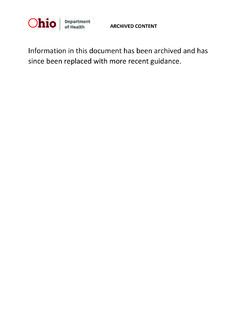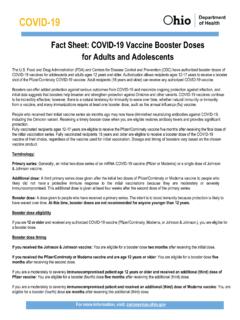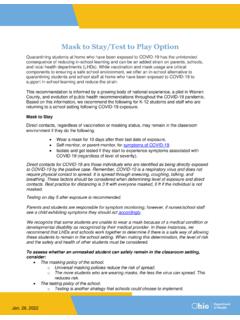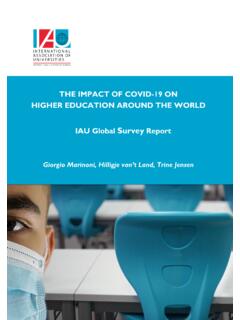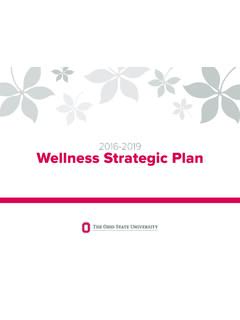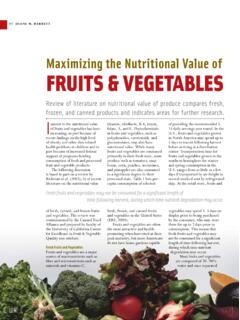Transcription of Archived 12-31-21
1 2021-22 SCHOOL YEARR evised 7/26/21 Archived 12-31-21As schools get ready for the 2021-22 academic year, the ongoing health and safety of students, staff, and volunteers remains paramount. While great strides have been made in controlling the spread of COVID-19, the virus remains a health threat. Although children are less likely to get severely ill from COVID-19 compared with adults, they are at risk of being infected with the virus that causes COVID-19, getting sick from COVID-19, spreading the virus to others, and having severe health outcomes. Because children 11 and younger cannot be vaccinated and less than a third of children 12 to 17 are fully vaccinated, it is strongly recommended that schools implement masking for students layered with other prevention strategies to protect people who are not fully Delta variant is rapidly becoming dominant in Ohio.
2 It is highly transmissible, increasing risk, especially for those who are unvaccinated. Because the Delta variant spreads so quickly, these strategies to reduce As students head back to school, the Ohio Department of health (ODH) recommends following the same layered prevention strategies that were remarkably effective at controlling COVID-19 last school year:Strongly recommend vaccinations for staff and eligible students. Vaccines are our best tool to protect students and prevent the spread of the virus. Wearing masks. Masks have been proven to be extremely effective in slowing the spread of the virus. Ohio researchers conducted an evaluation last year that showed that masking helped control the spread of the virus in Ohio schools. ODH strongly recommends that those who are unvaccinated wear masks while in school.
3 Additional measures including improving ventilation, maximizing distance between people, and practicing good hygiene, among others. Consistent implementation of these core prevention measures helped limit the spread of COVID-19 in the classroom during the 2020-21 academic year. Continuing to follow these recommendations will protect students as much as possible. EXECUTIVE SUMMARYOur goal is to keep students back in school, in-person five days a week. Students benefit from in-person issuing these recommendations, ODH is relying on current epidemiologic information, regulatory requirements, and law even as we anticipate full FDA approval of vaccines in the near future. ODH will continue to actively monitor these factors and will update this guidance as this situation continues to in school are critically important to protect students, teachers, staff, and health and Prevention Guidance for Ohio K-12 Schools3 in your community.
4 Visit gov to find where the vaccine is available in your community. Consider partnering with your local health department or other vaccine providers in your community to host vaccination clinics on-site before, during, or after school or in the summer leading up to the return to school. In partnership with local vaccine providers, consider hosting information sessions or offering pop-up clinics in conjunction with school activities. Consider offering flexible, supportive sick leave options ( , paid sick leave) for employees to get vaccinated or who have side effects after vaccination. Provide students and families flexible options for excused absence to receive a COVID-19 vaccination and for possible side effects after vaccination. Side effects are natural and indicate the body activating an immune response after receiving a vaccination.
5 Most side effects are minor and short in duration. Work with local partners to offer COVID-19 vaccination for eligible students and eligible family members during pre-sport/extracurricular activity summer physicals or in conjunction with other immunizations administered before the new school VACCINATIONCOVID-19 is a vaccine-preventable, respiratory illness caused by the virus SARS-CoV-2. The disease can spread rapidly among individuals who are not fully vaccinated and result in serious illness or death. Vaccination is the leading public health prevention strategy to end the COVID-19 pandemic. Achieving high levels of COVID-19 vaccination among eligible students as well as teachers, staff, and household members is one of the most critical strategies to help schools safely conduct in-person learning and allow safe participation in extracurricular activities and who are fully vaccinated against COVID-19 are at low risk of symptomatic or severe infection.
6 A person is considered fully vaccinated two weeks following the final dose in a two-dose vaccine or two weeks after a single-dose age 12 years and older are eligible for COVID-19 vaccination. We anticipate being able to vaccinate younger children as the academic year progresses. Strategies to Promote Vaccination of Eligible Students and Staff Encourage teachers, staff, students, and their families to get vaccinated against COVID-19 and share information from your local health department or partner providers on COVID-19 vaccination locations COVID-19 health and Prevention Guidance for Ohio K-12 Schools4 WEARING MASKS HELPS CONTROL VIRUS SPREAD AND PROTECTS STUDENTS AND STAFFW earing masks protects students, teachers, and staff from COVID-19 and other infectious diseases. COVID-19 is an airborne respiratory virus.
7 Wearing masks has been proven to prevent the spread of respiratory droplets that are created when people talk, laugh, sing, cough and sneeze. Last school year, Ohio researchers conducted an evaluation of interventions implemented in schools to help slow the spread of the virus including wearing masks and distancing. Their research found that wearing masks combined with distancing was effective in slowing the spread of the strongly recommends that those who are unvaccinated wear masks while in is especially important indoors, in crowded settings where physical distancing cannot be maintained, and for individuals who are not fully vaccinated. For those districts not opting to require masks, parents will still have the option to have their children wear masks while in school or participating in school : As noted above, it is recommended that masks be worn.
8 Children under 2 years of age should never wear : In general, mask use is not necessary when outdoors, including when participating in outdoor play, recess, and physical education activities. Use of face coverings can reduce the spread of respiratory droplets that, in infected people, carry and spread COVID-19. While masking in school is recommended for people older than 2 years of age, exceptions should be made for the following categories of people: People who cannot wear a mask, or cannot safely wear a mask,because of a developmental delay or disability. Discuss the possibility of reasonable accommodation with those who are unable to wear or have difficulty wearing certain types of for whom wearing a mask would create a risk to workplace health , safety, or job duty, as determined by relevant workplace safety guidelines or federal , particularly in areas of substantial to high transmission, the CDC recommends that people who are not fully vaccinated wear a mask in crowded outdoor settings or during activities that involve sustained close contact with others who are not fully health and Prevention Guidance for Ohio K-12 Schools5Be aware that wearing masks can be difficult for people with certain disabilities (for example, visual or hearing impairments) or for those with sensory or cognitive issues.
9 For people who are only able to wear masks some of the time, prioritize mask wearing when it is difficult to separate students and/or teachers and staff ( , while standing in line or during drop-off and pickup).School transportation The CDC continues to require that masks be worn on all public transportation, including school buses. This requirement is regardless of vaccination transportation services should follow applicable federal rules and regulations. Learn more at the CDC s Guidance for COVID-19 Prevention in K-12 Schools page. Facial Coverings The Centers for Disease Control and Prevention have said that COVID-19 spreads via respiratory droplets when an infected person coughs, sneezes, or droplets may pose an inhalation threat even when the person they are speaking with is at a distance and in an enclosed provide a barrier that prevents these respiratory droplets and smaller aerosolized particles from spreading from one person to another.
10 They protect the person who is wearing the mask by preventing the spread of that person s respiratory droplets as others speak, cough, sneeze or even sing. If both people involved in the conversation are wearing masks, it limits the particles passing between health and Prevention Guidance for Ohio K-12 Schools6 IMPROVING VENTILATIONCOVID-19 is a respiratory virus that is highly transmissible by air. Improving ventilation is a critical intervention that can help slow the spread of the virus. ODH recommends that schools increase ventilation within classrooms and other common spaces. Schools in Ohio have access to special, one-time federal funding through the Elementary and Secondary School Emergency Relief (ESSER) Fund. Projects to upgrade and improve air quality systems in school buildings are an allowable use under ESSER, and schools are strongly encouraged to invest in upgrades, aligned with the CDC guidance below, to their indoor air quality systems using these ventilation recommendations for different types of school buildings can be found in the American Society of Heating, Refrigerating, and Air-Conditioning Engineers (ASHRAE) schools and universities guidance Department of Education recently released further guidance for schools on how federal funds can be used to improve CDC calls ventilation a key part of maintaining healthy environments, and is an important COVID-19 prevention strategy for schools, especially when layered with other prevention strategies.

